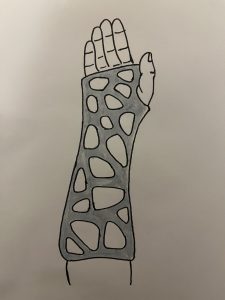– Brief explanation of project:
Orthopedic casts are used to heal millions of bone fractures each year. Conventional fiberglass and plaster casts have a number of drawbacks, including moisture susceptibility, pain, and lack of ventilation. Conversely, orthopedic casts that are 3D printed are a relatively recent yet exciting development. By utilizing state-of-the-art technology, these casts provide significant benefits over their traditional equivalents. Usually, depending on scans of the afflicted region, they are customized to meet the unique demands of the patient. The procedure entails creating a personalized cast model, which is then produced with 3D printing technology and provided to the physician for utilization. Specifically, these casts’ main advantages are their weather resistance, breathability, and personalization. They do have some disadvantages, though; the biggest one being the amount of time needed for manufacture. Traditional casts may be put on quickly, but waiting times for 3D-printed casts are longer. Challenges can arise from factors like cost and possible changes in tissue properties during scanning. Our goal is to create a cast that minimizes the drawbacks of the existing 3D-printed orthopedic casts by utilizing the advantages of both individualized design and 3D printing.
– Preliminary designs and manufacturing considerations: We must ensure that our design allows for the cast to be breathable and must endure any potential stresses or strains that may occur. Two of the largest manufacturing considerations that come to mind revolve around the biocompatibility of the material used in the print, along with the rigidity of the material which must be considered so that healing properly occurs in the patient. We have an initial drawing attached below, we are considering optimizing the design of currently marketed 3D printed casts:
– Proposed first print trial, experiments, or similar: We will begin by familiarizing ourselves with the 3D scanning technology available at the Makerspace, to scan one of our arms to produce a model, so that we can design a customized cast, perform some stress analysis, and print a scale model for the prototype in ABS given that ABS is biocompatible and suits additional material characteristics needed for a cast. Post-processing will most likely be needed in the form of support removal and sanding. We are also interested in experimenting with SLA printing for a variation of this cast in an attempt to see if we can develop parts which are more flexible in certain areas to allow for more functionality.
